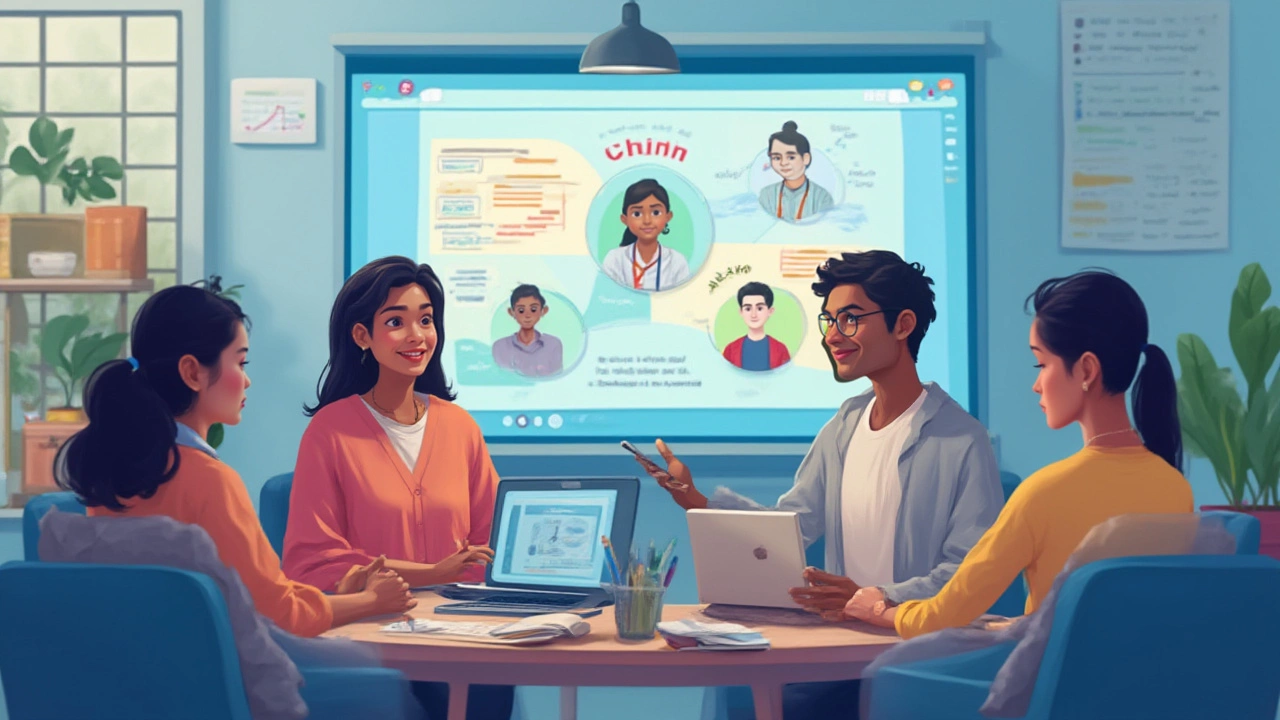Top eLearning Platforms: Best Online Learning Tools Compared
 Jul, 4 2025
Jul, 4 2025
Scrolling through courses at midnight or swapping textbooks for touchscreens, it’s wild how ordinary eLearning feels these days. Ten years ago, you might’ve argued it was just a trend, but with 2025’s numbers breaking records, the shift to digital learning isn’t slowing down. The global eLearning market hit more than $400 billion this year—a figure that’s almost hard to imagine until you see every kid in your neighborhood logging into a virtual classroom. What’s driving this? Access, flexibility, and the simple reality that the world doesn’t turn off for a snow day anymore.
What Sets eLearning Platforms Apart?
Not all platforms are built the same, even if they promise similar things. Sure, they all let you click through lessons or join video calls, but a closer look reveals wild differences in user experience and features. Some platforms serve corporate teams chasing upskilling, others focus on school-age kids or lifelong hobbyists. A standout eLearning platform doesn’t just throw information online—it builds a whole ecosystem around learning. Interactivity is king. Forums, quizzes, simulations, and collaborative projects add depth. If people can jump in and build, solve, or debate within the platform, it tends to stick.
Let’s talk mobile. In Canada, 84% of online learners prefer courses they can access on their phones, according to a 2024 Digital Learning Survey by Statista. That means platforms without strong apps are just missing out. Offline access matters too, especially in places where Wi-Fi is spotty. These aren’t frills—they’re essentials now.
Another game changer? Adaptive learning. Some of the best eLearning platforms use algorithms to adjust the speed and difficulty of lessons, so people aren’t getting left behind or bored out of their minds. If you take a quiz and bomb it, the next lesson can go back and review, while acing it might push you forward. Plenty of people who thought online classes felt isolating now feel seen with feedback and nudges in real time.
Lastly, a big one—analytics. Whether teachers or managers, knowing how learners are progressing helps shape what happens next. The platforms that offer dashboards live up to the promise of actually improving education.
Most Popular eLearning Platforms Students Actually Use
You’ve probably heard of a few big names. But which eLearning platforms are students actually clicking on, and what do they really offer?
- Coursera: Maybe you’ve taken a class on here yourself. Partnering with universities like Stanford and the University of Toronto, Coursera offers courses ranging from data science to philosophy. One cool part is the verified certificate—great for resumes and LinkedIn. In 2025, over 124 million users log in to Coursera for something beyond just a quick YouTube tutorial. The sheer range puts it in a league of its own.
- Udemy: If Coursera is the university class, Udemy is the workshop where anyone can teach (and almost anything gets posted). From practical Excel hacks to dog training, there are courses for every niche. Users love the permanent access to purchased courses.
- Khan Academy: Free and accessible, it started as a math resource and now covers sciences, history, and more. It’s especially big with K-12 students. Kids across Toronto use it for homework help, and teachers rely on its dashboard.
- Duolingo: Ever tried to get that daily streak learning French or Spanish? Duolingo’s gamified approach keeps folks hooked. In 2025, it averages over 80 million active users a month, with new interactive features involving real voice conversations with AI agents.
- LinkedIn Learning: This one is all about career skills. Video courses on leadership, marketing, programming—you name it. Many Toronto companies even offer it as a free perk in their employee packages.
- edX: Born from an MIT-Harvard collaboration, edX leans academic, offering professional certificates and micro-degrees. Universities use it to deliver entire degree programs online.
Here's a glance at some jaw-dropping numbers about platform reach:
| Platform | Monthly Active Users (2025) | Main Focus Areas | Main User Base |
|---|---|---|---|
| Coursera | 124 million | University-level, Professional Development | College, Working Professionals |
| Udemy | 70 million | Skills, Hobbies, Tech, Business | Adults, Entrepreneurs |
| Khan Academy | 35 million | Academic, K-12, Test Prep | Students, Teachers |
| Duolingo | 80 million | Language Learning | All Ages |
| LinkedIn Learning | 40 million | Career, Business, Tech | Professionals, Companies |
| edX | 48 million | Professional, Academic | College, Adult Learners |
Does brand matter? It does if you’re job hunting. Recruiters notice Coursera, edX, and LinkedIn Learning certificates. For younger students, Khan Academy and Duolingo deliver content schools can’t always squeeze in.

Lesser-Known Gems: Niche and Specialized eLearning Platforms
The big names get all the attention, but some platforms quietly build cult followings. Think of these as the hidden indie bands of the eLearning scene—hyped by their own communities, quietly reshaping how we learn certain things.
- Skillshare: Creatives love this place. You’ll find photographers, animators, writers, and designers teaching short, hands-on projects. Courses tend to be practical—how to create an Instagram brand, polish up portrait photography, or animate a short intro.
- Brilliant.org: This platform reimagines math and science. With puzzles and interactive lessons, it’s a hit among curious students and adults who’ve had enough of boring textbooks. In Toronto’s gifted programs, teachers actually integrate Brilliant into their lessons now.
- FutureLearn: A UK-based platform, but the global audience tunes in for humanities, health, and digital culture classes, especially from big-name European universities.
- Codecademy: Wannabe coders and mid-career switchers pick Codecademy for its powerful step-by-step lessons in nearly every popular coding language.
- Teachable: Not a traditional learning platform, but a tool that lets anyone create their own school. Many Toronto-based coaches and yoga instructors turned to Teachable when the pandemic shuttered gyms. Now, it’s home to thousands of micro-schools around the world.
- Babbel: Serious about language learning but not into cartoon owls? Babbel focuses on real conversational skills and cultural knowledge, not just vocab drills.
There are specialized platforms for mental health (like Mindvalley), non-profits (TechChange for global development skills), kids’ coding (Tynker), and health science pros (Osmosis). Each one targets its “tribe,” usually with a unique twist in the experience.
For parents or educators looking for an edge, these niche platforms make learning fun and tailored. If your student is obsessed with puzzles, Brilliant can transform how they see math. Or, if you’re considering an online side hustle, Skillshare and Teachable open doors you won't find in traditional edtech.
What to Look For in an eLearning Platform
Things get confusing fast when every website shouts about having “the best course catalog” or “AI-powered feedback.” How do you choose? Here’s what to seriously consider so you don’t end up wasting hours (and money) on a dud.
- Content quality: Slick interfaces mean nothing if the lessons are boring, outdated, or wrong. Is the platform working with credible experts or just influencers chasing clicks? Sample a free lesson if you can.
- Certification: If you’re after a job or a promotion, verify if the course offers a legitimate credential, not just a downloadable PDF. University-branded certificates, industry badges, and LinkedIn integration all add credibility.
- User community: A solid forum or comment section makes a difference, especially when you hit a mental roadblock. Khan Academy and Coursera nail this. Look for active discussion boards, live workshops, or peer review options.
- Accessibility: If you or your colleagues need subtitles, screen readers, or simply to learn at your own pace, make sure the platform is set up for it. Big platforms are getting better, but smaller ones vary.
- Mobile and offline access: In 2025, busy learners don’t always sit at a desk. If you want to learn during your TTC commute, a strong app is essential.
- Pricing and flexibility: With so many options, you never have to pay hundreds up front. Monthly subscriptions, pay-per-course, even free trial periods—you can mix and match. During Toronto’s 2024 teacher strike, many parents found free options that outperformed paid ones for K-12 basics.
- Security and Privacy: Not the most exciting topic, but critical. Top platforms keep your data safe and don’t spam you with endless marketing emails.
Here’s a scenario: a friend in downtown Toronto, out of work after last year’s tech layoffs, picked up a project management certificate on Coursera. Six months later, it genuinely helped her land a new job. But what made the difference for her wasn’t just course content—it was real skills practice and feedback. "I felt like I was working with a mentor, not just watching videos," she told me.
As quoted by Dr. Jordan Johnson from the Digital Education Research Centre, University of British Columbia:
"Online platforms that emphasize accountability and community outperform passive video courses in both completion rates and learner satisfaction in national studies."

Tips for Getting the Most Out of Your eLearning Platform
Ready to launch into a new course or sign up for a year of learning? Take a minute before you click the purchase button. Even the best eLearning platforms won’t unlock your brain unless you build a routine and use the features the developers worked so hard on. Here’s how the pros keep momentum:
- Set small goals: Finish a module, ace a quiz, or even show up daily for a week. Progress fuels motivation, and most platforms reward streaks or badges.
- Get social: Don’t do it solo! Even introverts benefit from discussion boards or group projects. Studies say learners who interact with peers are 54% more likely to complete their courses.
- Book “class time”: Treat it like a gym session—non-negotiable. Even 20 minutes a few times a week beats weekend binge-watching six hours of video.
- Ask for help: Hit roadblocks? Most platforms have mentors, discussion threads, or live sessions. You won’t look silly—questions are the point.
- Apply it fast: If you’re learning coding, try a mini project. Taking a French class? Order in French at the next café lunch. Put the new skill to use so it sticks.
For parents with kids on eLearning, be there as a cheerleader, not a boss. Set up a visible progress chart; when your kid aces a module, make a big deal out of it. Adults can tack certificates on their LinkedIn or even print them out—seeing visible markers of success really works.
Here’s an expert tip: subscribe to course update notifications. Some platforms refresh material constantly, and you’ll want to be first to jump on it—especially if you’re working in a fast-changing field like tech or digital marketing.
Stick to platforms with solid customer support, too. If your account gets locked or you’re having trouble with a payment, fast help will save a ton of frustration.
The world’s changed. Online learning isn’t just for emergencies—it’s part of building a future-proof career, finding hobbies, and even connecting across borders. Pick the right platform, use it smartly, and you’ll wonder how you ever crammed for tests in a library basement or struggled through a clunky office seminar.